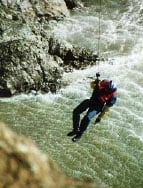 Coast Guard Group/Air Station Astoria was established on 14 August 1964 at Tongue Point Naval Station with a crew of 22 officers and 104 enlisted men. Two single engine Sikorsky HH-52A helicopters were operated from that location. The helicopters staged from the Port of Astoria Airport in nearby Warrenton during periods of inclement weather. On 25 February 1996 the Air Station was permanently moved to its present location at the Port of Astoria Airport. The HH-52A helicopters were replaced with three larger twin engine HH-3F Pelican helicopters in March 1973. Two HU-25A Falcon jet aircraft were assigned to the Air Station in October 1983 to enhance the law enforcement effort and contribute to Search and Rescue (SAR) and logistical missions.
Coast Guard Group/Air Station Astoria was established on 14 August 1964 at Tongue Point Naval Station with a crew of 22 officers and 104 enlisted men. Two single engine Sikorsky HH-52A helicopters were operated from that location. The helicopters staged from the Port of Astoria Airport in nearby Warrenton during periods of inclement weather. On 25 February 1996 the Air Station was permanently moved to its present location at the Port of Astoria Airport. The HH-52A helicopters were replaced with three larger twin engine HH-3F Pelican helicopters in March 1973. Two HU-25A Falcon jet aircraft were assigned to the Air Station in October 1983 to enhance the law enforcement effort and contribute to Search and Rescue (SAR) and logistical missions.
The larger helicopters and the two additional jet aircraft required a larger facility. A 4.8 million dollar construction and modification project began in 1982 and was completed in August 1984. A new medical building and new shop buildings were also built during the project. A third HU-25A Falcon was added in June 1988. Then in September 1987 the HH-3F Pelicans were replaced with 3 HH-65 Dolphins. In 1995 both the HU-25A Falcons and the HH-65 Dolphins were replaced by the HH-60J medium range recovery helicopters.
Group/Air Station Astoria has an area of responsibility which stretches from the Queets River on the Washington coast, south to Cape Kiwanda on the Oregon coast; and the Colombia River east of Longview Washington. The Group provides support functions to all units stationed in Northwest Oregon and Southwest Washington. The group also provides operational support to the National Motor Lifeboat School and the Advanced Rescue Swimmer School, both located in Ilwaco, Washington.
The rescue Swimmer Program has evolved dramatically from the initial concept. In 1995 it was recommended that advanced training be provided in hazard awareness and various new procedures, techniques and equipment that rescue swimmers did not receive in Rescue Swimmer School or normally encounter during operations at their air stations. Astoria was determined to be the best location for such a school, as the rugged coastline, demanding surf and prevailing high seas provided ideal training conditions. In April of 1996 the Coast Guard Advanced Rescue Swimmer School was established. Twice a year for one month periods, advanced rescue swimmer training is conducted for pilots, hoist operators, flight mechanics and rescue swimmers from all Coast Guard air stations.
Today, (2009) Group Astoria is composed of Air Station Astoria in Warrenton, Oregon; Station Grays Harbor in Westport, Washington; Station Cape Disappointment in Ilwaco, Washington; Station Tillamook Bay in Garibaldi, Oregon; and Aids to Navigation Team Astoria at Tongue Point, Oregon.
Support infrastructure includes a medical clinic and 160 housing units, as well as the Coast Guard facility at Tongue Point. The Group also provides operational, logistical, and administrative support to two Astoria-based medium endurance cutters, a 225’ buoy tender also home-ported in Astoria, the National Motor Lifeboat School, and the Advanced Helicopter Rescue School.

